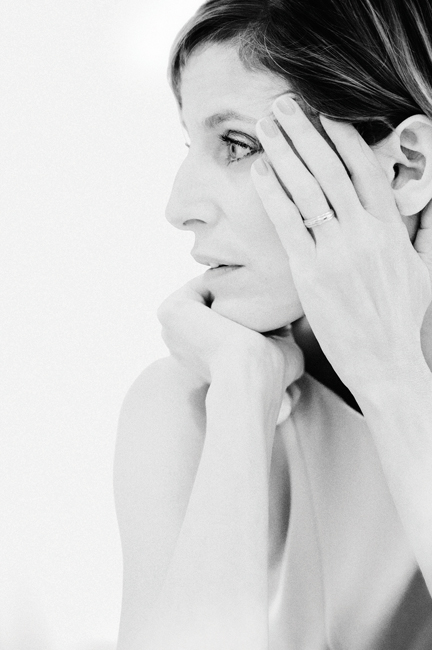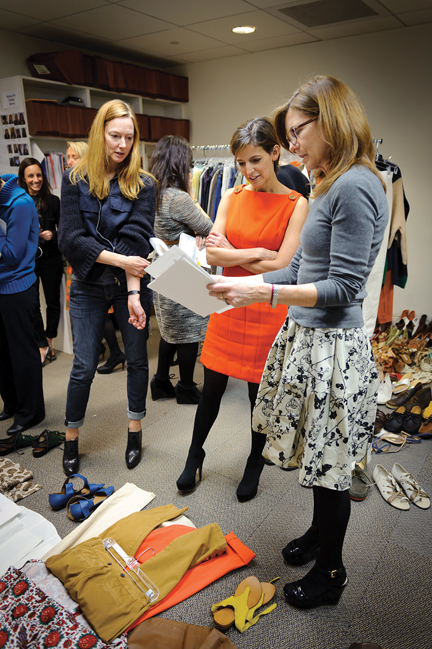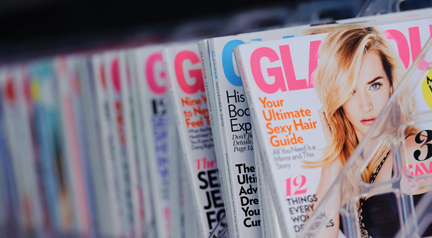Style and Substance
As editor-in-chief of Glamour magazine, Cindi Leive ’88 commands an audience of 12 million women every month.
 Get a glimpse of Glamour’s July cover, graced by the blond beauty Blake Lively, star of Gossip Girl: “100 Dos & Don’ts of Summer” … “25 Beauty Questions You Ask All Summer, Answered” … “How Sex Really Feels—With Movie Star, or in a Threesome, or When He’s a Virgin” … “Quiz: What Foods Does Your Body Really Need? (Besides Chocolate, Obviously)” … “So Many Steals! Whole Outfits Under $100, & More.”
Get a glimpse of Glamour’s July cover, graced by the blond beauty Blake Lively, star of Gossip Girl: “100 Dos & Don’ts of Summer” … “25 Beauty Questions You Ask All Summer, Answered” … “How Sex Really Feels—With Movie Star, or in a Threesome, or When He’s a Virgin” … “Quiz: What Foods Does Your Body Really Need? (Besides Chocolate, Obviously)” … “So Many Steals! Whole Outfits Under $100, & More.”
“Glamour’s role is to make readers feel great about their lives and to give them, in every issue, a balance of fun and fashion and compassion and support,” says Cindi Leive ’88, editor-in-chief of the magazine, which boasts a readership of 12 million and outsells 98 percent of magazines on the newsstand. “My editorial vision is that it’s completely possible for a magazine to embrace—wholeheartedly embrace—fashion and beauty, and at the same time tackle serious issues of substance.”
“I have plenty of smart female friends who can get into a heated discussion about whether platform shoes are a good or bad thing for the world and also talk about child brides in Yemen. There’s no reason those two things can’t cohabitate.”
It’s a winning formula. Under Leive’s editorship, Glamour has won three National Magazine Awards, including the highest honor, the award for General Excellence, in 2005. In 2007, the magazine won for Personal Service for an article titled “What No One Ever Tells You About Breast Implants” and, in 2010, Glamour received the newly created Magazine of the Year Award, which recognizes a magazine that excels in both its print and digital formats.
Leive discussed the digital transformation and the media at Swarthmore last fall when she delivered the annual McCabe Lecture on the topic, “Would Walter Cronkite Have Tweeted?” (short answer: yes). Leive’s own tweets speak to the range of her responsibilities: “Gearing up for tomorrow’s official release of our 100 Recipes Every Woman Should Know book! TWO Today Show segments … wish me luck, folks” … “@IWMF [International Women’s Media Foundation] conference for women journos in DC today: countries from Belarus to Uganda are here” … “Back at Glamour HQ today. One day left to work on the May issue which is freakin’ ENORMOUS. Happy chaos.” She also tweets the occasional fashion or beauty tip—“I’m late to this, but Essie Smokin’ Hot is an excellent nail color”—and documents, via Tweets, the major fashion weeks, most recently in Paris: “Theme of Vuitton show was ‘fetish.’ One great bag and pair o’boots after another” … “McQueen finale. These are not trivial frocks here.”
“I admit,” Leive said in her McCabe Lecture, “that I joined women’s magazines with some of the prejudice that one might expect from a Swarthmore graduate fresh out of seminars like Feminist Interpretation of Scripture. I thought the job would be fun, and fluffy, and an easy thing to do before I went on to the truly important work of my life, which was, well, who can remember? What I found instead were some of the liveliest, most inquisitive women I’d ever met, writing and editing about the subjects that I cared most about.”

While reviewing outfit choices for an upcoming photo shoot, Leive inquired about the affordability of the clothing: “Is anything cheap in here?” She says that “a woman should never read this magazine and feel like she’s not rich enough or thin enough or whatever enough to have a piece of the fantasy.”
Leive’s first major story was one she pitched about low pro-secution rates in rape cases, even in situations where police felt confident that a crime had occurred. She contacted district attorneys from across the country to ask why they had not pressed charges in particular cases. “I would call them, and as soon as I would say I was from Glamour, they would completely loosen up. They’d start laughing and say, ‘Oh, you want to put me in a centerfold?’ or, ‘You’re going to shoot me for a fashion story?’ Then they would be completely open and honest, because they thought being from a magazine called fluffy little Glamour, I couldn’t possibly be threatening.”
“I got some good stuff reporting that story.”
At Swarthmore, Leive was features editor of The Phoenix, (Pamela Haag ’88 recalls all-nighters spent cutting and pasting headlines and stories with X-acto knives and glue), and a writing associate. An English literature major and religion minor, Leive graduated Phi Beta Kappa and with high honors and won the Jesse Holmes Prize for the best essay on any topic in religion—about the power dynamics between Ruth and Naomi. “My family, who knew that I was not particularly religious, found it completely hilarious that I was minoring in religion,” Leive recalls. “But the Book of Ruth, that’s also a good short story. I was seeing it as good writing with good women characters.”
Leive landed an editorial assistant job at Glamour after college, but she planned to attend graduate school in English. She received a Mellon Fellowship and decided first on Duke and then Columbia, but each time she would try to get up the nerve to tell her editor she was quitting, she would feel a pit form in her stomach. She ended up staying at Glamour for 11 years, climbing to the deputy editor position before accepting the editorship at Self. She returned to Glamour in May 2001 as editor-in-chief. She served as president of the American Society of Magazine Editors from 2006 to 2008 and is on the board of the International Women’s Media Foundation.
 At Glamour, one of the accomplishments Leive is most proud of is expanding the magazine’s Women of the Year Awards to honor a broader range of women. Last year’s winners ranged from Julia Roberts to Dr. Hawa Abdi and her two daughters, also doctors, who have converted their family farm in Somalia into a refugee camp that’s home to 90,000 people, mostly women and children. Glamour called Dr. Abdi, who has defended the camp against Islamic militants, “equal parts Mother Teresa and Rambo.”
At Glamour, one of the accomplishments Leive is most proud of is expanding the magazine’s Women of the Year Awards to honor a broader range of women. Last year’s winners ranged from Julia Roberts to Dr. Hawa Abdi and her two daughters, also doctors, who have converted their family farm in Somalia into a refugee camp that’s home to 90,000 people, mostly women and children. Glamour called Dr. Abdi, who has defended the camp against Islamic militants, “equal parts Mother Teresa and Rambo.”
Leive’s own stance toward the world is curiosity leavened by optimism—an attitude she associates with Swarthmore. “I’m still just such a big believer in the value of a Swarthmore-type education and the whole idea of being curious about the world and also looking at the world in an essentially optimistic way,” Leive says. “Swarthmore really promotes critical inquiry, but I never felt like it was a cynical or a skeptical place. I always felt like it was, in general, filled with people who were sincere.
“That’s a very Glamour attitude too. If it’s a choice between sounding overly sincere or overly sarcastic, we’ll always choose sincerity over sarcasm. It doesn’t mean we can’t be funny and flip and all that, but that’s never enough. There’s got to be some heart to it.”
At Glamour’s headquarters on a Friday in March, Leive’s editorial eye was constantly in evidence—whether it was noting typos during a meeting to review the iPad edition of the June issue or scrutinizing outfit choices for an upcoming road-trip–themed fashion shoot. For the photo shoot she suggested a pair of short shorts be replaced with a pair of skinny pants and inquired about the inclusion of affordable wardrobe items. “Is there anything genuinely cheap in here?” Don’t forget, she reminded the fashion editors, if in any picture it looks like the car is moving, the models must be wearing seatbelts.
Leive had appeared on Today earlier that day to talk spring fashion trends—orange is (or was) in, as are wider-leg pants options; “hats are everywhere, if you dare.” She herself wore a sleeveless, lightly pleated poppy-red Tory Burch boatneck dress with gold button detailing, black tights, and high black platform shoes. (If you’re keeping score, she is in the platforms-are-good-for-the-world camp; “I’m 5 ft. 2 inches, so I think they’re a gift from God.”) Lining Leive’s 16th-floor Times Square office are pictures of her interviewing then-Senator Barack Obama and Senator John McCain during campaign 2008 and former President George W. Bush in the Oval Office. In another picture, she poses with Secretary of State Hillary Clinton, a past Glamour Woman of the Year winner.

Leive joined Glamour as an editorial assistant “with some of the prejudice that one might expect from a Swarthmore graduate fresh out of seminars like Feminist Interpretation of Scripture.” She earned high honors in English literature; the Jesse Holmes Prize for the best essay on any topic in religion—for a paper about the power dynamics between Ruth and Naomi—and a Phi Beta Kappa key.
As editor, Leive is not just in charge of the print magazine and the website (Glamour.com) but an expanding brand that encompasses special events like the Women of the Year Awards, a three-book deal with Hyperion (the first book, 100 Recipes Every Woman Should Know, came out in April), Glamour apps, a jewelry line with HSN, a partnership with match.com (Glamour Matchmaker), and a series of special newsstand editions.
“You have to fight harder than ever to get a reader’s attention,” Leive says. “When I grew up, it was not, ‘Are you going to read magazines?’ it was, ‘Which magazines do you read?’ Now, I don’t take for granted at all that a girl who’s 15 or 16 is going to be a magazine reader. Obviously, I want to do everything I can to give her reasons to fall in love with Glamour the magazine, but I also want and need to come up with a cajillion other ways for her to experience Glamour the brand. Maybe for her it won’t be Glamour magazine, maybe it’ll be Glamour.com. Maybe it’ll be Glamour apps. Maybe she’ll be buying our ebooks. I think it’s just a new challenge, figuring out how to reach people who aren’t going to automatically walk to the newsstand and buy a magazine once a month.”
Leive has always loved magazines. “I literally remember running home from school when I was in eighth grade on the day I knew my Seventeen magazine would be in my mailbox.” Among the magazines she reads for pleasure are The New Yorker (iPad edition) and New York Magazine; Entertainment Weekly, People, and the British publication Grazia for entertainment news; and Bon Appétit, Cooking Light, and Real Simple—“for the domestic goddess wannabe in me.” Leive lives in Brooklyn with her husband, film producer Howard Bernstein, 8-year-old daughter Lucy; and six-year-old son Isaac. They have a weekend home in Dutchess County, N.Y., in a town called Milan (“I have actually gone before from Milan, New York, to Milan, Italy. You do not pack the same clothes for both places.”)
Bernstein writes the editorial note for Glamour’s annual “Guy Issue,” and in January wrote a column about living for a day by what he sees in women’s magazines. He said he went vegan briefly (for breakfast and lunch); obsessed about his abs; and wore jeggings (for the uninitiated, a cross between jeans and leggings): “7:15 a.m. Commence putting on jeggings … 7:55 a.m. Complete putting on jeggings … 7:57 a.m. Arrive in kitchen; 5-year-old son says, ‘Daddy, you look like Mommy!’ … 8:20 a.m. Strange numbness in lower extremities.”
“The thing about Cindi is that she’s this combination of an incredibly confident, take-charge leader and the most likeable person you’d ever meet,” says Bernstein. “It’s infuriating!” he laughs.
“A good way to describe her is someone who’s able to make you feel like you are in charge of a situation when she might actually be the one who’s in charge—not in a tricky way, but someone who knows better than you do but still makes you feel good about yourself.”
 Which brings us back to the point that Leive wants you to feel good about yourself when you finish reading Glamour. “We always say that we want this to be a magazine that is going to make you feel better, not worse, about your life after you close its pages, that a woman should never read this magazine and feel like she’s not rich enough or thin enough or whatever enough to have a piece of this fantasy,” Leive says.
Which brings us back to the point that Leive wants you to feel good about yourself when you finish reading Glamour. “We always say that we want this to be a magazine that is going to make you feel better, not worse, about your life after you close its pages, that a woman should never read this magazine and feel like she’s not rich enough or thin enough or whatever enough to have a piece of this fantasy,” Leive says.
Glamour strives for what Susan Goodall, the editorial development director, describes as the voice of “your best friend, or someone who tries to think about what it is you need to know and tell you.” The magazine is characterized by an empowering, every-woman, faux-confidential tone: “The Best Spring Jackets for Your Shape” … “Five Things You Have to Tell Your Gyno” … “Proof You Can Pull a Career 180” … “I Wish My Sex Life Were More ______! Expert advice for every naughty need.”
“I do think the Glamour voice stems a lot from the way [Cindi] looks at things,” says Goodall. “Which is we’re all real people, we’re all women, and we share with each other the mistakes we’ve made. We laugh, and we also learn from each other.”
Elizabeth Redden ’05 is a freelance writer and graduate instructor of writing at Columbia University.
 Email This Page
Email This Page